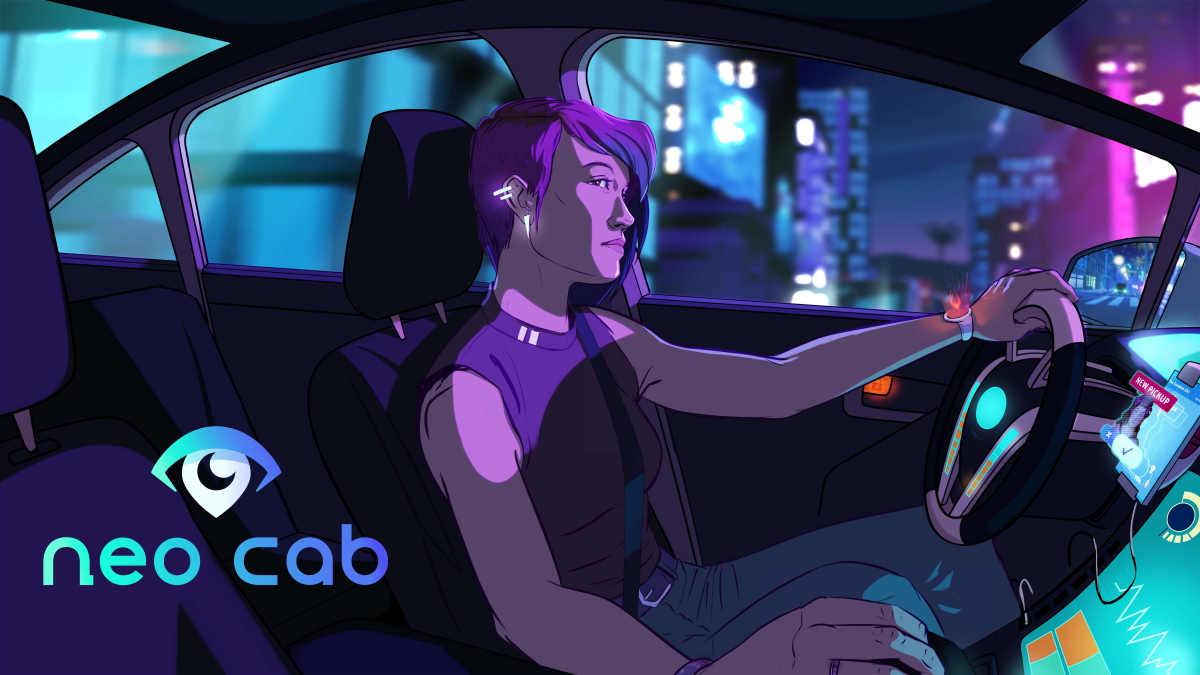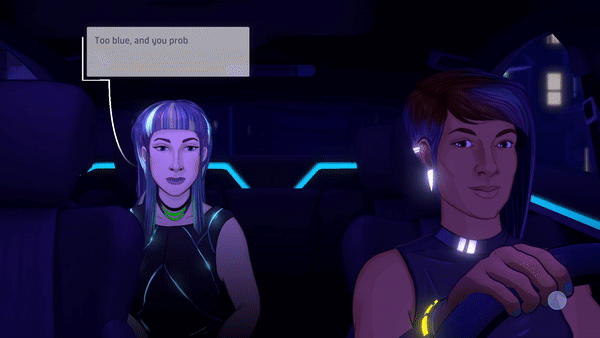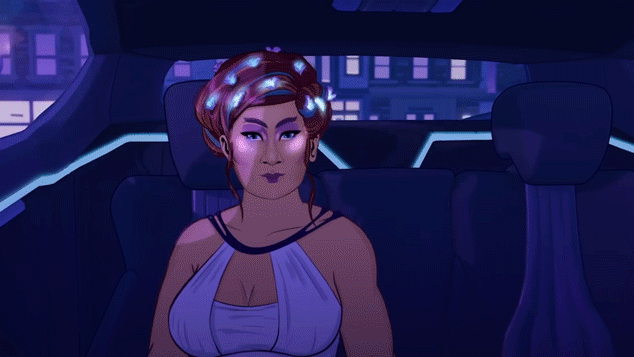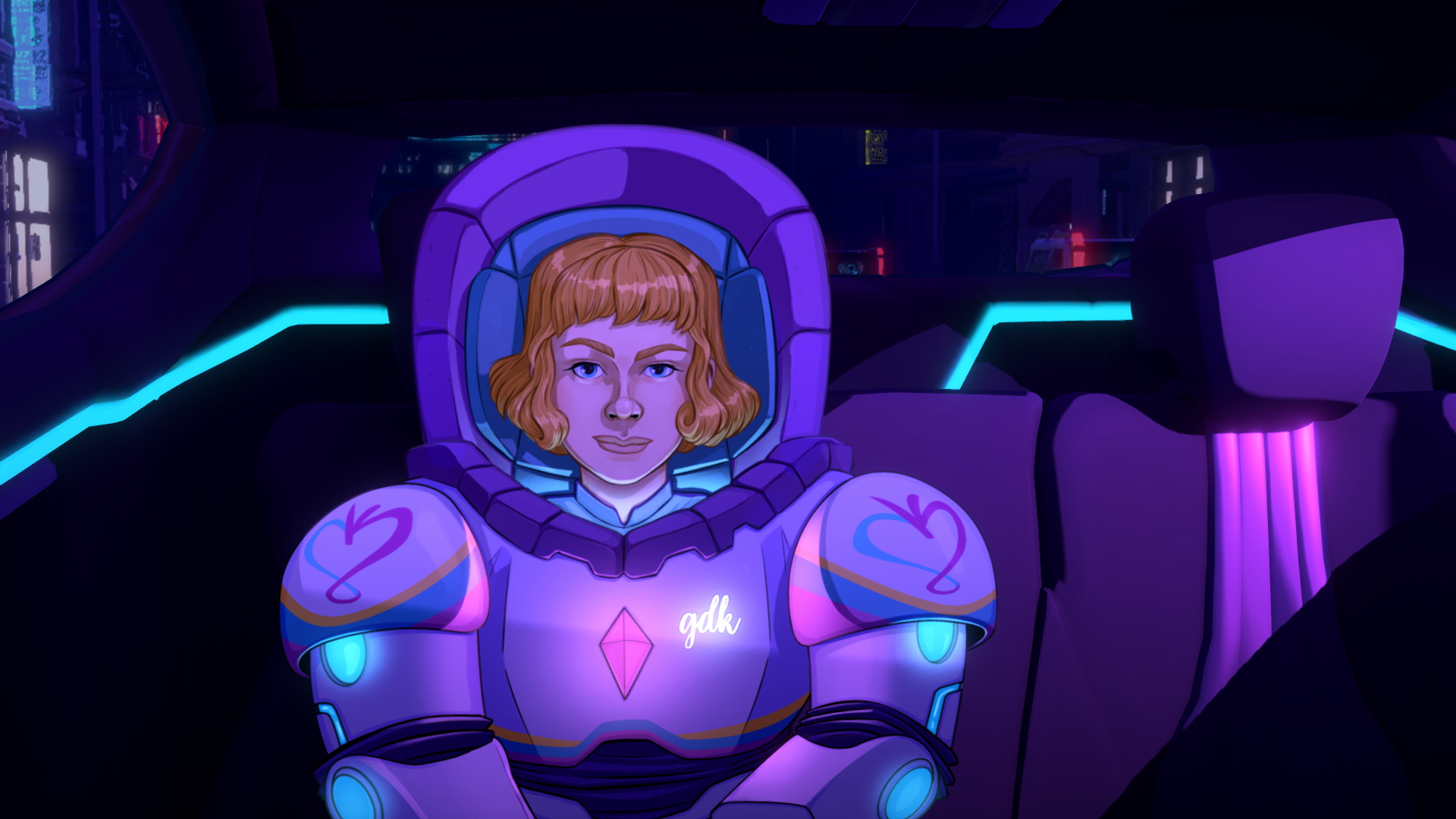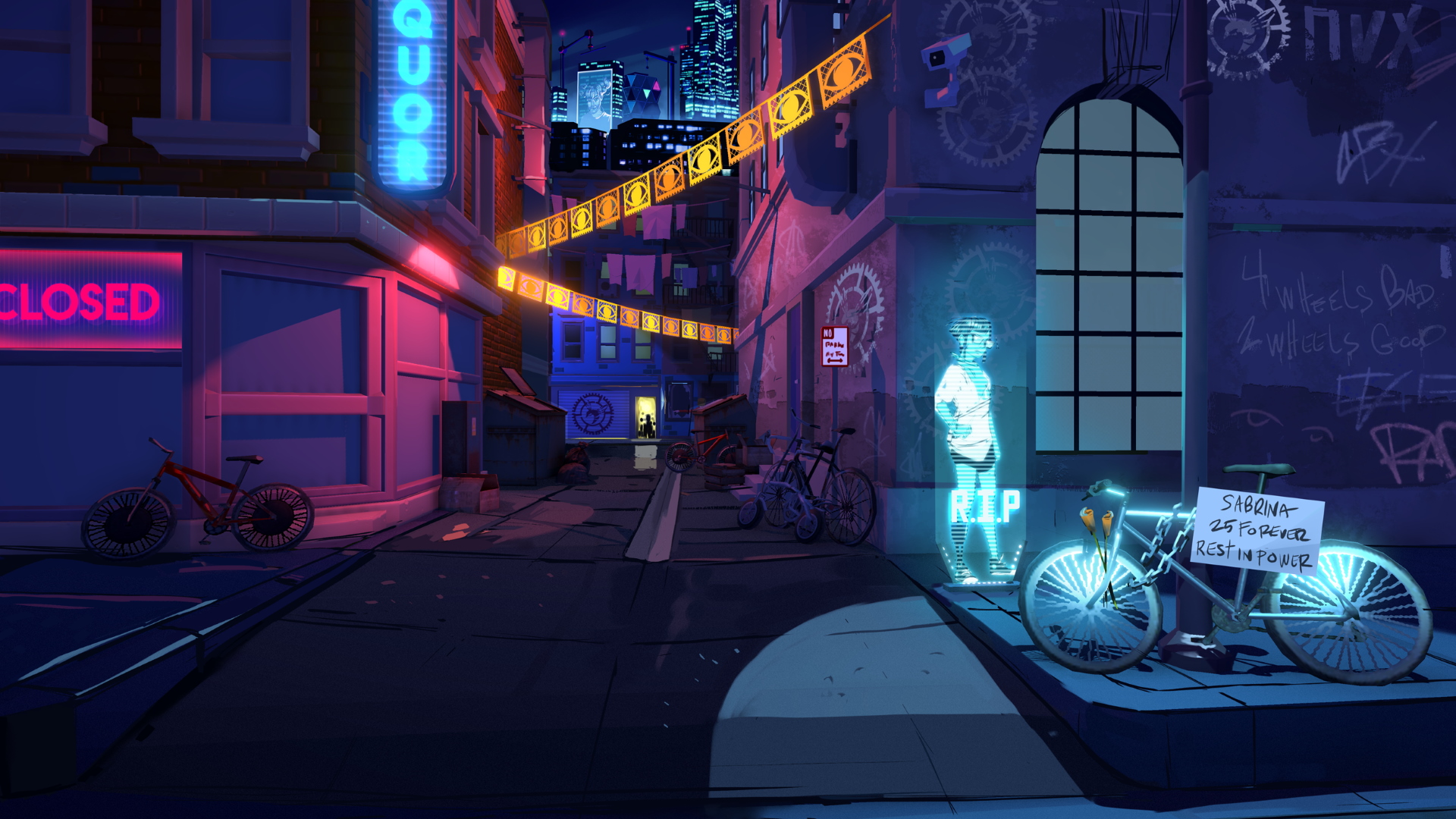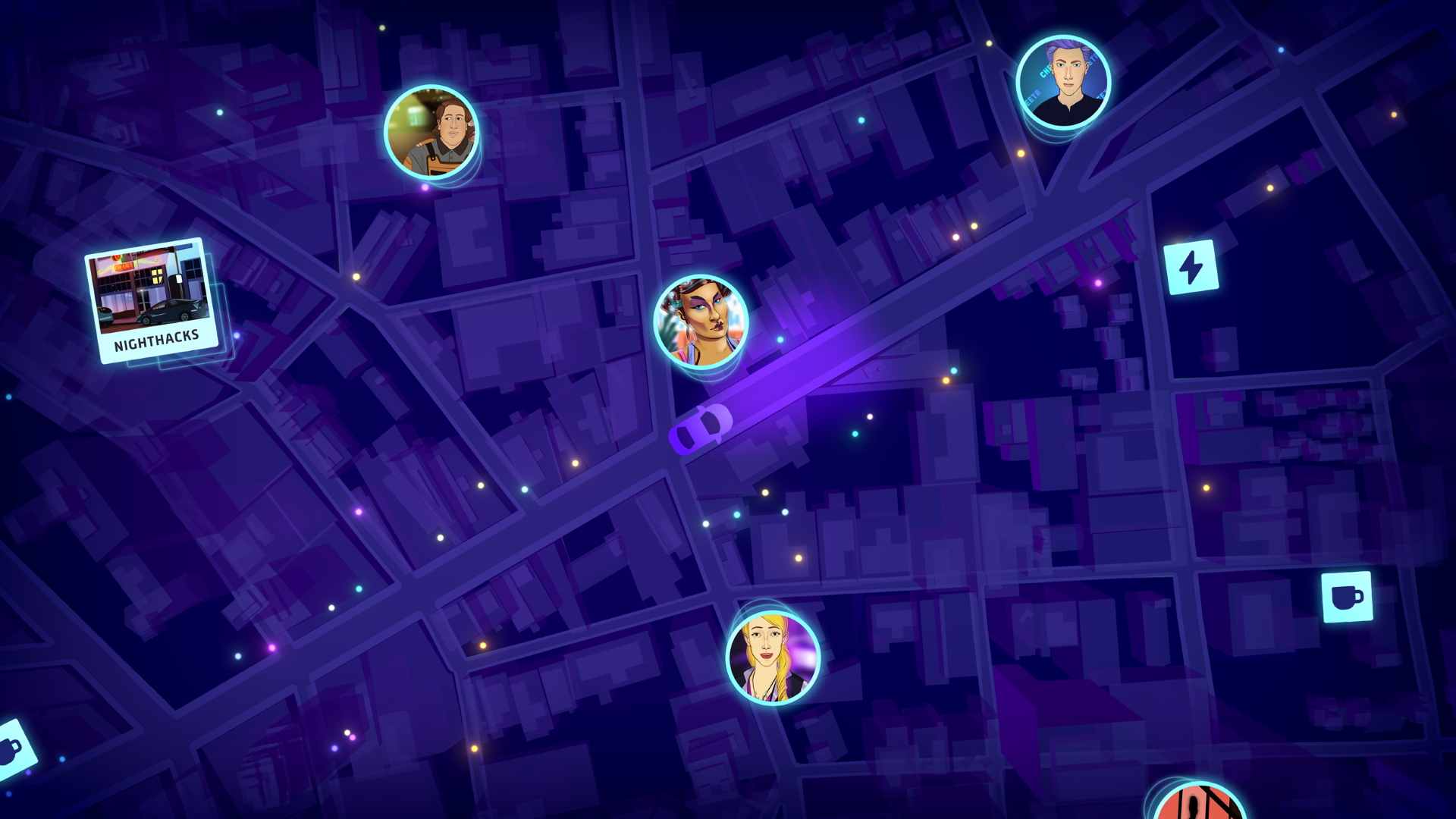Recently, Evolve PR hosted an open Q&A session with the Creative Director of Neo Cab, Patrick Ewing. We’re sharing it with you in its full transcript to find out the great details about Neo Cab, just released this week!
Patrick: So I’m Patrick Ewing, the “Creative Director” and founder of Chance Agency… basically what this means to me is that I had the initial idea for the game and built our first prototypes, and I then assembled the true Neo Cab team so that we could make something real and good- making a game is a deeply collaborative process- it’s nothing without a strong multidisciplinary team that can speak the same design language.
When I was first working on the idea that would become Neo Cab (then called “Getaway”) I was at Campo Santo. We had just shipped Firewatch, on which I did coding, game design, and a some story work.
I was eager to make another narrative game for adults- like Firewatch, a story that engaged with some tough human issues while also being entertaining, soothing, and beautiful.
Before Campo Santo I was an early engineer at Twitter, working on the Twitter website. I was one of the first 100 employees there, working from 2009 – 2014… a lot of Neo Cab’s engagement with Silicon Valley’s technocratic culture comes from what those years
I’m originally from Brooklyn, NY and I’m a film school dropout / self-taught software engineer. I think that about covers it for me!
Evolve PR: So Neo Cab is based around the life of a Rideshare driver. Did the team have to use the service’s a lot as research as both a driver and passenger?
Patrick: Great question! Before we started writing, we set up some interviews with “Rideshare” drivers and other gig workers- friends of friends, mostly. Lyft, Uber, Zesty and Postmates were the folks we talked to right off the bat.
We also read through a few of the unofficial online forums where gig workers gather to share tips, make jokes, and ask for help. We learned a ton from these meetings- it was apparent right off the bat that every driver has at least one amazing story to tell.
This combined with a bunch of ad-hoc conversations with cab drivers over the past few years gave us a lot of insight into the stories, the game-mechanics, and the lingo of rideshare drivers. For example “pax” for passenger or “deactivated” for fired… all of that is real rideshare terminology.
Evolve PR: The FeelGrid system is an excellent idea to help players gauge what to say in a conversation. What was the thought process behind creating this system?
Patrick: Thanks! The idea of a wearable device that shows your emotions dates back to a short story I wrote nine or ten years ago. I’m fascinated by the ways we all, as humans, are unaware of our own emotions, sometimes purposefully ignoring or repressing them to fool ourselves into feeling differently. The story wasn’t particularly good, but the idea resurfaced in the early days of writing Neo Cab.
Because we were modelling the experience of a real Lyft/Uber driver, we knew that the player would be judged at the end of each ride by a stranger, and that this rating would be crucial for preserving their job. But I could see right away that this would make a very easy AND boring game- you would just be incentivized to be “nice” all the time to get 5 stars.
So the wearable bracelet idea from 10 years ago came back to me- with this, the player could immediately see Lina’s emotions, and be forced to deal with them, and to see how they react to player choice.
By making emotions visible, it could become a real gameplay system, and interact with the “star rating” mechanic- creating “tough tradeoffs” between doing well at your job and personal wellbeing- the kind of choices all of us have to make every day, but amplified because your whole job is riding on that 5 star rating.
Evolve PR: Since Neo Cab has somewhat of a “multiple paths” system in play, how many different endings does the game have?
Patrick: In terms of the framing story – the top level mystery and what you must choose once you unravel it- there are three endings.
Each has a distinct flavor, and also a large scale story effect that stems from the choices you’ve made along the way, and the emotional skills you’ve shown off in the final scene. There are also per-character endings for certain pax who you’ve formed deeper relationships with.
Evolve PR: How deep can your relationships with your Pax’s become?
Patrick: That’s a tough one because it some ways it arrived fully formed? haha
Even though in retrospect I’m sure it snowballed over time. The idea of having a lot of choice has always been core to me, and so thinking of a dark, neon lit map filled with strangers to meet was incredibly exciting- it’s like a framework where anyone could be your next ride. Plug that into the worries about automation and the gig economy that San Francisco (my home) is in the midst of right now, the weird dynamics of being rated by strangers, and the emotional landscape of absorbing whatever needs these strangers have when they step into your cab, and I knew we were on to something.
Our amazing Art Director, Vincent Perea, was the person who most suggested we try to NEVER leave the cab… to focus on that experience.
He’s got a great mind for embracing constraints and making a game feel highly polished though that kind of discipline.
Evolve PR: How would you describe your outlook for the future of the real world, particularly regarding automation and AI?
Patrick: I think automation, in MANY jobs, is inevitable- it’s just a matter of when it happens, and how prepared we are as an economy & society to make that transition. In the world of transportation that our game explores, long-haul trucking will be the first to go fully automated, AFAICT.
As a job, long-haul trucking is terrible on your health, a real risk in terms of accidental deaths, and keeps people apart from their local communities and families… so it’s not a job that I think inherently deserves to exist forever. That said, it employs a huge number of people in this country, and was once a solid middle-class job you could raise a family on… so if Tesla and Uber were to sweep in and eliminate all of those jobs in a short period of time, that would be a disaster. It’s these sorts of gray areas that we wanted to explore in this game- we wanted to look at the future of automation and labor without dystopian OR utopian goggles on.
Similarly, I think it’s troubling that sometimes when an AI eliminates a whole profession, it doesn’t actually do what it promised it would, in terms of e.g. making the service cheaper or better.
In many cases, automating something like an insurance worker’s job leaves everything exactly the way it was… it’s just that all the money is going to a smaller number of people (the folks who own and operate the algorithm) instead of a lot of people (the many humans who were individually doing the calculations before)
In the best possible scenario, automation could lead to safer streets, less human drudgery, shorter work hours with the same quality of life. We could make it a goal to gradually have humans working less and less, and filling their remaining time with more fulfilling pursuits.
Instead, it seems like we are seeing the working week stay at a fixed length, jobs continuing to be drudgery, and wages stagnating… it’s not promising right now
Evolve PR: Why are video games, a medium that emerged from computer technology, better suited to point out the potential risks of the same technology (in this case: human redundancy) they found their origins in?
Patrick: I think it might be Ian Bogost who first pointed out that what games are uniquely good at doing are exploring systems. A book can tell you one story, but a game can offer you the ability to explore that story from many angles, to poke and prod at parts of it and see how it responds, and this means it can be about more than just one person’s story, one person’s experience
We’re mostly focused on one tiny sliver of the overall systems of tech automation and centralization, of course, but the threads are in there, I think… by putting yourself in Lina’s shoes and having to choose to take an emotional hit just to get those 5 stars and get a little ratings bonus… I hope people feel like they’re plugged into this system
Evolve PR: The effect of emotions on communication is very important in this game. What did the developer team read/search to do this well in dialogues?
Patrick: A great book on this topic is “How Emotions are Made“.
Hearing an interview with this author, and then reading the book, was the final piece of the puzzle for making the Feelgrid work as a mechanic. We had known for a long time that the system needed to exist, but not how it should actually work.
It’s a balancing act between an emotions system that’s so simple that it feels dumb and non-human, or one that’s so complex that it’s impossible to understand or too complicated to write dialog for.
“How emotions are made” introduced us to the Circumplex Model of Human Affect, which was the basis of the Feelgrid.
It also gave us the insight that all emotions start in the body… there’s a baseline way that you feel “in your bones” that’s universal
That was the right level of detail for this game- the 4 main colors and the gradations between them.
In dialog, then, the player can see that Lina is “red” (worked up, feeling badly) but then they get to put their own meaning onto this (is she angry? anxious? scared?)
The book suggests that in a sense this is what we are all, always doing. Emotions start vaguely but intensely, in the body, and then we apply our own mental models on top of that feeling to become specifically “jealous” or “angry” etc.
Our designer Laura Sly did a really nice talk on the specifics for those who are interested:
Evolve PR: This year seems to be the taxi videogames one: Night Call first, and Neo Cab then. Which has been the inspiration for you to create such a game?
Patrick: I feel like I’ve spoken a bit about the initial inspiration on our team, but I can say that (knowing the Night Call team… we’ve gotten to hang out a bit since we discovered each others’ games in mid-production) I think both our teams are first and foremost storytellers.
And we both saw that a late-night cab ride is a uniquely powerful storytelling moment- two or three strangers crossing paths for a brief moment, anonymously, an opportunity for honesty and intimacy… or perhaps danger… or deception etc.
Shows like Taxicab Confessions or movies like Night On Earth or Collateral are so powerful in terms of the stories they tell in such a constrained setting.
Evolve PR: This is a very intimate version of a cyberpunk tale. What led you to choose this kind of setting?
Patrick: Intimacy is sorely lacking in games! I don’t know about y’all, but I can only save the world so many times before it gets boring
I find it much more relatable to meet somebody who is having a bad night, or a bad year, and seeing if we can connect over that and maybe help them turn that around.
In a very crowded games marketplace that felt like a missing space. Brie Code calls this impulse to help people in crisis “tend and befriend”, it’s the complementary stress response to “fight or flight”.
Nearly all games trigger your fight or flight response. We wanted to make a Brie Code game to possibly balance that out!
Evolve PR: The interaction between the protagonist and her passengers is very human, also thanks to the possibility of the player to give multiple answers. How complex was it to manage all the emotional aspects of the dialogues?
Patrick: VERY COMPLEX haha
I highly recommend speaking to our Writing Lead, Paula Rogers, about the techniques she had to develop to manage a story that branches in two ways- on choice, and on emotion.
On a given ride, there is 2x-3x more writing in that ride than is possible to see in one playthrough, because of all this branching.
It also is a real superpower to write a character who’s mental state is simultaneously in 2 or 3 different states. It’s pretty mind-bending and takes a ton of practice.
Evolve PR: Relationships and humanity are very important in Neo Cab, and they are presented as threatened by big corps. Where you afraid that people might understand the game’s critique as technophobia instead of a hard critique of technological development as a false idea of progress?
Patrick: Yes, we definitely didn’t want to fall into the trap of “We live in a society!” critiques… technological change is never all good, or all bad. and humans manage to keep a lot of the best/worst parts about us steady through it all
That’s why we steered clear of things like “phone addiction” or “i’m becoming a cyborg” type stories and focused more on societal things, and universal social things
Dating through an app, for instance, isn’t more or less awkward than dating by phone, or through singles ads in a newspaper. But it is differently awkward when the app starts interfering more directly in the courtship process (this is an example from the Fiona storyline).
But yeah, we made a point that our biggest radicals in the game, Radix, are “anti-car, not anti-tech”.
We didn’t want to caricature any person or political position.
Evolve PR: How did you come up with this setting – are you afraid the world will turn out this way?
Patrick: I would refer to the earlier questions about Automation, for the most part. We started with the cab-driver setting, and then began thinking about how Uber (and Lyft) have the stated goals of firing every one of their drivers and replacing them with AIs. That’s in the paperwork, it’s what their stock price valuations are entirely based on… so in that sense, this future does feel less like sci-fi and more like the plan of present day Megacorps. Capra, our automated giant that is Lina’s former employer, is a company I can very much imagine existing.
Uber (for example) has menaced journalists who’ve looked into them, worked with stolen technology from other companies, covered up internal harassments allegations (allegedly, allegedly, please don’t sue our indie game company Uber)
So yeah, if you picture a world where companies continue to gobble up smaller fish, tech keeps getting centralized, and industries are disrupted by AI… all of that money and power flows up to the biggest fish. Uber wants, Lyft, Tesla, Google… all of them want to be that fish.
Evolve PR: Why did you choose to make the game without voice actors?
Patrick: Primarily we made this choice because we wanted people to play this game on the go. We targeted Nintendo Switch and iOS from the get-go. When travelling especially, players want to read and progress quickly, so they can take a “ride” in Neo Cab on their morning commute, or before nodding off at night.
Having no voice acting makes the game feel more like a good book- it progresses as fast as you can read it, and you can hear your favorite characters’ voices in your head.
Evolve PR: Why did you choose a narrative focus?
Patrick: Narrative games are in our bones! Coming off of working on the Firewatch team, and as a lifelong lover of classic adventure games (LucasArts especially) and modern narrative games like 80 Days and Papers, Please… this was the only type of game we considered for our first game as a studio.
Evolve PR: It’s obvious from the game’s aesthetics and music that you guys are big cyberpunk and synthwave fans. What media has been the most inspiring for the creative direction of this game? Any movie or artist in particular?
Patrick: Ahh, I wish Vincent Perea was here to chime in on this, but we’ve talked about this at such great length I can just say what he would say :p
We were massively inspired by the street photography of Liam Wong (who is also a game designer!)
For the shots and storyboarding, we were inspired by The Night Of, Taxicab Confessions, Taxi Driver and Collateral
Film-wise, we borrowed some animation techniques and moments from Ghost in the Machine.
And of course the original Blade Runner and Syd Mead in general, that’s inescapable.
Evolve PR: What made you all make the decision to do a soft launch on Apple Arcade first?
Patrick: Well, when we first heard about Apple Arcade, it was still a complete secret, but the idea was immediately appealing to us… so many people getting a chance to try our game for (almost) free? It’s a super exciting moment.
Especially for a pure-story game, which is a niche that can sometimes struggle to find an audience. So as soon as we were chosen to be part of AA, we were more or less on their schedule.
We were going to launch when AA launched, you know? And had to work out our other dates around that date… our others platforms could launch anytime, but not BEFORE AA.
That’s about all I can say!
Evolve PR: Managing your life as a driver is very similar to real life. Filling up your car with charge, different prices and even having different places to sleep around the city with some being “better” than others. Are there certain factors of that loop that you wanted to add that were canned?
Patrick: Great question!
So yeah, in any game design you have to avoid simulating too much. If it’s not worth the players’ attention, it shouldn’t be on screen. If the mechanic doesn’t slot in with the overall story of the game or the tone of the world, it should be canned.
We cut all sorts of things, little and big. Originally charging stations were going to be discoverable mid-ride, but the risk of running out of fuel in the middle of nowhere wasn’t worth the challenge of having to find stations.
We used to simulate weather at random too, which boosted surge pricing… I still like that mechanic, we mostly cut it because of performance reasons on mobile (ran sims are hard to do well with our graphics style)
Evolve PR: I noticed some non-binary/trans representation in one of the characters in your game. How was the character design process when planning on the different Pax’s that you’d drive around?
Patrick: Paula Rogers (Managing Editor / Writing Lead) gave a good example of how we create a Neo Cab character (in this blog post).
With Azul, we made sure that we understood their own view of their gender first before we started with the character design.
It was also essential that one of our team members is non-binary and uses they/them pronouns- I don’t think we could have felt fully comfortable with the representation without having them to talk to during the design process.
This was one reason we also decided to make the fact that Azul is nonbinary implicit- Lina just picks up on this from the way Azul dresses and carries themselves, and naturally switches out of respect. Turns out she’s right and they don’t even need to discuss it.
Despite all the dystopia of the economy in Neo Cab, this was one aspect that felt like a hopeful, and very Californian, near-future… gender expression that’s not a strict binary doesn’t have to be what defines Azul’s character arc. It’s just a part of their character, not the whole of it.
Evolve PR: Where can we find you and the team on Social?
Patrick: Our game is @neocabgame on all platforms, I’m @hoverbird on all platforms, and more info about the game (like our dev log, press kit etc.) is at neocabgame.com
Neo Cab launched on October 3rd.

